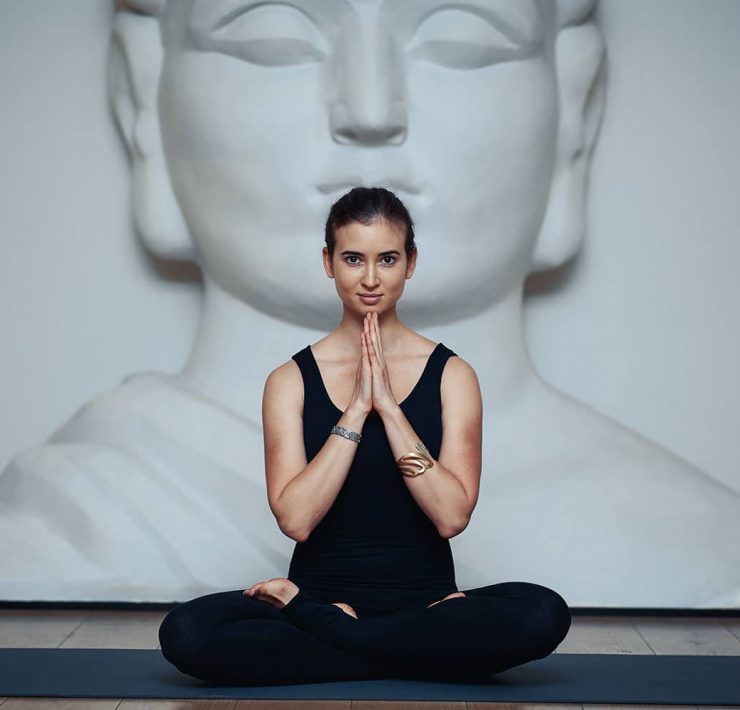
Meditation coach Emma Morrison is the go-to person for those…
In your yoga practice, you may have come across the term Dharana.
But do you know what Dharana is exactly?
Dharana is the binding of consciousness to a single point.
It can be an internal or external point but it ultimately quiets the mind to focus on a singular entity rather than allowing the mind to engage in its usual busyness.
Dharana is a unique process for everyone in that you get to choose the restricted area of your focus and allow your mind to wander within that. Gradually, that area becomes smaller and smaller until you have reached Dharana and found peace within yourself.
An interesting facet of Dharana is that its very being encompasses the absence of ego.
Ego, or Ahankara in Sanskrit, is the master of distraction.
When engaged in a variety of activities all at the same time, our ego demands our attention but can never truly engage in any of the tasks.
Our attempt to multitask actually takes us away from each activity, dividing our attention and focus into smaller and smaller increments.
In this way, ego hinders our ability to present. But Dharana attempts to eliminate that.
In simple terms, Dharana is the enduring focus you maintain throughout your yoga practice.
Some yoga practitioners emphasize a focus on your breathing to train you to focus in on what you can control within your practice. This is because there are many different obstacles that can arise when striving to reach Dharana.
Let’s explore some of the obstacles you might experience in your practice.
1. Comparing Yourself to Others

An essential question in yoga is asking what serves you. Does it serve you to move around in a particular posture or remain static throughout?
This can be easily translated to our self-comparison of others. While it is an easy thing to fall into, what is its purpose?
Drawing comparisons is a natural instinct we embody as humans, but whether it functions as a valuable tool is up for debate.
Particularly in your yoga practice that is specifically designed by and for you, allow yourself to fall into what is meant to be. If we judge our own process, we hinder our own success.
So instead, try asking yourself the following question when you feel yourself drifting into a place of comparison:
Does it serve me to compare myself to others?
What will I gain out of these comparisons?
Are these comparisons drawing more harm than they are beneficial?
What is the end goal of this quandary?
Most often, you will find that the time you spend comparing yourself to others can be directed towards cultivating a greater sense of self.
The time you spend with yourself is invaluable. So don’t let your energy go to waste by engaging in a process that is ultimately to no one’s benefit.
2. Comparing Your Current Practice to Your Previous Practice

If you’re doing yoga every day or can remember every practice you’ve ever done, you likely recognize when some postures are easier to do than others.
As with any committed process, there will be ups and downs, ebbs, and flows. Some days will feel better than others. But that doesn’t mean the worst days are insignificant.
Yoga is all about being present. What happened in your previous practice should only inform your continued growth, not present a standard for you to hold yourself up against.
Again, the energy you spend towards comparing your current practice to your previous practice can easily be directed towards finding growth in new places.
Ask yourself what the benefit of this comparison is.
3. Letting Your Mind Wander

Practicing presence of mind is at the very core of yoga and meditation. But chastising yourself for letting your mind wander is not a solution either.
Rather than framing this as an obstacle, perhaps it is more beneficial to examine this as an inevitability.
Your mind will wander. How you choose to deal with it is what counts in your practice.
Drawing our mind back to the present is a consistent practice within yoga and helps us toward reaching Dharana.
While minds will wander, yoga is about training the mind.
It also provides an opportunity for you to exercise compassion and empathy towards yourself.
How often do we get to engage in that process?
Allow these moments to be an opportunity to recognize the teacher that resides within you.
Guiding yourself back to the present, you act as your own teacher and offer yourself assistance. You are reflecting the benefits of what you have been given.
This opportunity is not one to pass up, but rather one to relish in and cultivate.
Now that we’ve got a handle on what obstacles we may run into, let’s dive into the benefits of Dharana and the teachings we can learn from it.
The Benefits of Dharana

Dharana is the mental aspect of yoga that strengthens the mind and exercises control.
What you have learned on the mat in the physical sensations of yoga is now being applied to your mentality. You are applying your physical environment to your internal landscape.
Dharana allows you to cultivate a greater sense of focus when other distractions can arise. And distractions will arise.
Dharana is both rest and strengthening for the mind.
Particularly when dealing with areas of stress, Dharana offers us a place to quiet down and take refuge within ourselves when our environment may not be as hospitable as we’d like.
It is a constant practice of exercising control within ourselves when we have no control over our external circumstances.
This practice allows us to cultivate a more comfortable home inside of ourselves that we can recall at any given moment.
The process itself can also provide incredibly valuable information.
What is drawing our focus away from ourselves?
What do we consider a greater priority than our own wellbeing?
And when we find ourselves distracted, what is our initial response?
Are we harder on ourselves than we need to be and why?
All of these questions are meant to strengthen your understanding of self and broaden your process in creating a practice that provides rest for your mind.
Dharana Off the Mat

While our yoga mat is a great place to exercise our Dharana, it is an important tool that exists beyond the mat and past the physical sensations of our yoga practice.
In a world where our attention is demanded at multiple times of the day through technology, social media, professional life, and personal life, Dharana encourages us to focus on a singular project at a time.
Our constant stimulation can make our mind restless. Dharana attempts to settle the mind.
To put this into practice, start by examining the activities you do in your life and consider where you may be overextending yourself.
It can be anything as simple as watching tv while eating. Try just eating.
Going on a walk while looking at your phone. Just go on a walk.
Instead of reading a silly article, try reading a book that requires more of your uninterrupted attention.
All of these strategies are meant to elevate your meditation practice and be applied to your everyday life. Meditation is an ongoing practice, not just something we leave on the mat.
So how are some ways that you can practice Dharana?
1. Practice Your Mantra

Mantra-based meditation practice allows you to focus on a central idea.
Sometimes, mantra-based meditation practices consist of the participant repeating the mantra over and over again, exploring the different meanings from within.
Other times, the participant just repeats a set of sounds that have no meaning. In this practice, the words themselves are not the focus, but rather the vehicle to guide you towards a single-pointed awareness.
The act of vocalizing is another vehicle to hone in your focus.
Similar to chanting, your body will react to the constant vibrations that you are emitting through your vocal cords, diaphragm, and chest.
These vibrations will continue to resonate throughout your entire body while relying on your breath control which ultimately roots you in the present moment.
By focusing on consistent repetitions of sounds, vibrations, or breathing, we open ourselves up to the sensations we have become accustomed to since they are always present.
But nothing can be more grounding than recognizes the ebbs and flows that exist within our own body.
2. Try a Visual Meditation

Visual meditations can enhance your practice of single-pointed awareness.
Some choose to light a candle and focus on the flame. Others use mandalas or a spot on the wall.
The goal is to find a singular point of focus and allow everything else in your periphery to fade away from view.
If you’re having trouble finding focus within your mind, visual mantra meditations allow you to focus on a physical entity.
Through the process, your mind will start to veer from the path. But that object will give you a stable visual for you to fall back on and guide your mind back to your desired path.
3. Visualize Your Desires

Visualizing your desires merges both a visual and cerebral point of focus.
It is a great skill for manifesting your desires and allows us to work through the blockages or obstacles we may be experiencing.
Having your goals focused on a clear picture will help you see that your desires are attainable.
Keeping a vision board is a great way to keep pictures in front of you at all times and to remind you that the perceived obstacles are just distractions.
4. Turn Off Your Devices and Set a Timer

Stepping away from technology and setting up an allotted time for your practice is a great way to set boundaries.
Setting boundaries in and of itself recognizes your limitations but does not judge them. It takes these limitations and addresses its needs.
So often, if our phone so much as lights up, we feel compelled to pick it up and become distracted. But answering calls and text messages can wait.
Setting a timer will give you peace of mind that those tasks can be returned later. But for right now, your focus is centered and without distraction.
Even if it’s taking time to be with a loved one, set your devices away. Make it a point to be fully present in their company and engage in the opportunity to connect uninterrupted.
Final Tips for Practicing Dharana

Dharana is a process. While it is a space in your mind that allows for rest and focus, it is not an end goal that once achieved dissipates into nothing.
Dharana is a continual process of strengthening your mind to focus on singular entities at a time.
Because it is a process, there will be highs and lows. Do not get discouraged by the lows. If anything, they will inform the highs and provide a greater sense of understanding of your unique process.
Don’t be afraid to set boundaries.
Recognizing your limits is a great way to begin engaging in what tools and strategies will work for you. If you need to put away technology in order to be absolutely focused at the moment, do it.
If you find yourself drifting and wandering away from your single point of focus, take the opportunity to be kind to yourself.
You are committing to your practice regardless of the outcome and that in itself is something to be cherished.
Dharana strengthens the mind and will not respond to us tearing ourselves down.
What's Your Reaction?
Meditation coach Emma Morrison is the go-to person for those living in Salt Lake City, Utah, who need to release stress and tension or simply dive deeper into their meditation practice. In her writing, you’ll receive useful information on how to live a more fulfilling life.














